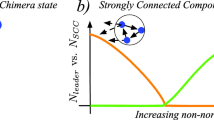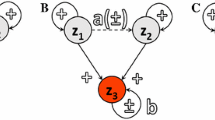Abstract
We have described a decirculation process which marks perturbations of network structure that are necessary for nonlinear network dynamics to proceed from one circulating state (a limit cycle) to another stable state (a limit cycle or a fixed point). Armed with the decirculation process, a sort of decirculating maps and their structural properties have also been built, dedicated to showing that circulation breaking taking place in nonlinear network dynamics can collaborate harmoniously toward the completion of network structure that generates attractors (equilibrium states). Here we wish to extend the notion of decirculating maps to the notion of depathing maps. The extension allows us to reshape network structure not only on the occasion of circulating states but on the occasion of any required path states. This gives a crucial improvement in generating circulating state shifts more feasibly.
MSC: 47H10, 37F20, 92B20, 00A71, 68T05, 91E40.
Similar content being viewed by others
Dedication
Dedicated to Professor Wataru Takahashi on the occasion of his seventieth birthday.
1 Introduction
Pattern generation in complex biological systems may be understood by means of the concepts of nonlinear network dynamics [1, 2]. The modeled systems can be formed by large numbers of interacting units whose dynamical properties tend to emerge through the collective interactions of many units. The modeled systems generally reach one of possible multiple stable states (alternative stable states) [3–5], which have multistability governed by the control parameters assigned to evolutionary network structure. State shifts between multiple stable states can be induced by the decirculation process [6], which marks a quantified determinant of the reshape of network structure that is sufficient for shifts from one circulating state (a limit cycle) to another stable state (a limit cycle or a fixed point). The decirculation process is generally stated as follows: ‘the occurrence of a loop of unit states in the modeled systems leads to a change in network connections, which feeds back to reinforce interacting units to tend to break the circulation of unit states in this loop.’
Armed with the decirculation process, a sort of decirculating maps and their structural properties are built in [7, 8], dedicated to showing that circulation breaking taking place in nonlinear network dynamics can collaborate harmoniously toward the completion of network structure that generates attractors (equilibrium states). Here we wish to extend the notion of decirculating maps to the notion of depathing maps. The extension allows us to reshape network structure not only on the occasion of circulating states but on the occasion of any required path states. Hence it can generate circulating state shifts more feasibly. It reveals the depathing process which is generally stated as follows: ‘the occurrence of a path of unit states in the modeled systems leads to a change in network connections, which feeds back to reinforce interacting units to tend to break the flow of unit states in this path.’ Operator construction for path breaking is also put in the section at the end, displaying the tendency toward path breaking aiming to control nonlinear network dynamics.
2 Depathing maps
Let denote the binary code consisting of all 01-strings of fixed length n. Denote by a path of states in , meaning that , , and for some . Specifically, we call that Ω is a loop if .
For every , we assign an integer, denoted by , according to the rule
We refer to the resulting matrix as the depathing map of Ω. (If Ω is a loop, then the depathing map is equivalent to the decirculating map defined in [7, 8], where we have explained why the terminology is used in connection with circulation breaking.) For example, let . Then
Consider the dynamical system of n coupled units modeled by the equation [6, 9]
where is the vector of unit states at time t, is the coupling matrix of n coupled units, denotes the units that adjust their states at time t, and is a function whose i th component is defined by
otherwise , where is the threshold of unit i and the function  is the Heaviside function: for , otherwise 0, which describes an instantaneous unit pulse. The dynamical system generates the vector of unit states according to (2), resulting in the phase flow , .
is the Heaviside function: for , otherwise 0, which describes an instantaneous unit pulse. The dynamical system generates the vector of unit states according to (2), resulting in the phase flow , .
With the depathing map , we are bound to consider the linear functional on the Hilbert space of all real matrices endowed with the Hilbert-Schmidt inner product .
Theorem 2.1 Let be a path of states in . If and satisfy
then for any initial unit state and any updating , , the resulting phase flow of (2) cannot behave in
for each .
Proof For any 01-string , we define
Suppose, by contradiction, that there exist , , , , and such that . Let
Then and . Indeed, if or , then
contradicting the path assumption . According to (1), we have
Since and for each , we conclude from (2) that
Combining (4) and (5) shows that , contradicting (3), and that completes the proof. □
3 Operator control on path breaking
Denote by a path of states in . For each , we say that the state is in the position m of the path Ω. For each 01-string , let
Let us recall that the symmetric difference of two sets U and V is the set , each of whose elements belongs to U but not to V, or belongs to V but not to U. For every , let
Here denotes the collection of the positions m of the path Ω, in which unit i changes its state from to or from to , whereas (resp., ) denotes the collection of the positions m of the path Ω, in which unit i changes its state from to (resp., changes its state from to ). For every , define
which can be regarded as a measure of synchronous activity between units i, j, that is, if units i, j tend to change their states synchronously (resp., asynchronously) in Ω, then (resp., ). For every , define
which can be regarded as a measure of self-sustaining activity of units i, j, that is, if unit i or j tends to maintain more self-sustaining states in Ω than unit or , then . We refer to the resulting matrices and as the measure of synchronous activity and the measure of self-sustaining activity derived from the path Ω of states in , respectively.
Let . Denote by the Hilbert-Schmidt inner product in , i.e., if and , then . Define . Let
where . The set collects all the combining operations of the operators and , which will determine a clamp of network modification by .
Fix . Define and . Since , , , and , we have
and hence, by (9),
Furthermore, according to the proof in [[8], Theorem 1], the following assertion holds:
Combining (9), (10), and (11) shows that
With the notation and arguments above, we describe operator control on path breaking as follows.
Theorem 3.1 Let and . Let be a path of states in . Then, for every operator , there exists such that
Hence, by Theorem 2.1, the dynamical system of n coupled units modeled by the equation
cannot behave in
for each .
In the following, we give an example to construct a sort of operators . Let and . Let . Then
Associate to each a real number such that
-
(1)
for each , if , then ;
-
(2)
(see Table 1 for a choice of ). We may select and , where if , otherwise 0, such that exactly one of the following holds:
-
(1)
for and ;
-
(2)
for and
(see Table 1 for a choice of and Table 2 for ). Consider the shift function σ on given by
for each . Since is positive semidefinite, we have
For such a choice of , let be such that
where . Then, for any choice of with and for each , we set , where is such that
(see Table 3 for a choice of ). Thus, by (12) and (13), we have
Hence (see Table 4 for a choice of ).
References
Schöner G, Kelso JAS: Dynamic pattern generation in behavioral and neural systems. Science 1988, 239: 1513–1520. 10.1126/science.3281253
Strogatz SH: Nonlinear Dynamics and Chaos: With Applications to Physics, Biology, Chemistry, and Engineering. Westview Press, Cambridge; 2000.
May RM: Thresholds and breakpoints in ecosystems with a multiplicity of stable states. Nature 1977, 269: 471–477. 10.1038/269471a0
Beisner BE, Haydon DT, Cuddington K: Alternative stable states in ecology. Front. Ecol. Environ. 2003, 1: 376–382. 10.1890/1540-9295(2003)001[0376:ASSIE]2.0.CO;2
Scheffer M, Carpenter S, Foley JA, Folke C, Walker B: Catastrophic shifts in ecosystems. Nature 2001, 413: 591–596. 10.1038/35098000
Shih MH, Tsai FS: Decirculation process in neural network dynamics. IEEE Trans. Neural Netw. Learn. Syst. 2012, 23(11):1677–1689.
Shih MH, Tsai FS: Neural network dynamics without minimizing energy. Abstr. Appl. Anal. 2013., 2013: Article ID 496217
Shih MH, Tsai FS: Operator control of interneural computing machines. IEEE Trans. Neural Netw. Learn. Syst. 2013. 10.1109/TNNLS.2013.2271258
Shih MH, Tsai FS: Growth dynamics of cell assemblies. SIAM J. Appl. Math. 2009, 69: 1110–1161. 10.1137/070697471
Acknowledgements
This work was supported by the National Science Council of Taiwan.
Author information
Authors and Affiliations
Corresponding author
Additional information
Competing interests
The authors declare that they have no competing interests.
Authors’ contributions
Both authors contributed equally and significantly in writing this paper. Both authors read and approved the final manuscript.
Rights and permissions
Open Access This article is distributed under the terms of the Creative Commons Attribution 2.0 International License (https://creativecommons.org/licenses/by/2.0), which permits unrestricted use, distribution, and reproduction in any medium, provided the original work is properly cited.
About this article
Cite this article
Shih, MH., Tsai, FS. Depathing maps for circulating state shifts. Fixed Point Theory Appl 2013, 195 (2013). https://doi.org/10.1186/1687-1812-2013-195
Received:
Accepted:
Published:
DOI: https://doi.org/10.1186/1687-1812-2013-195




